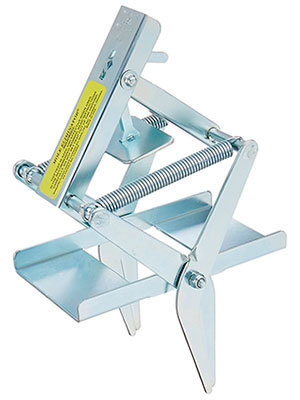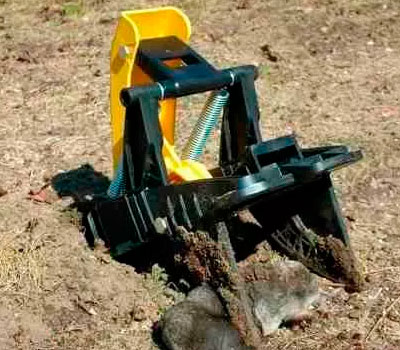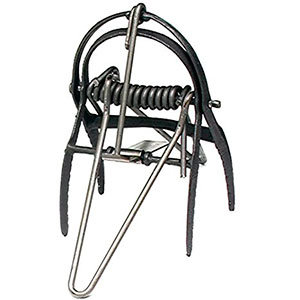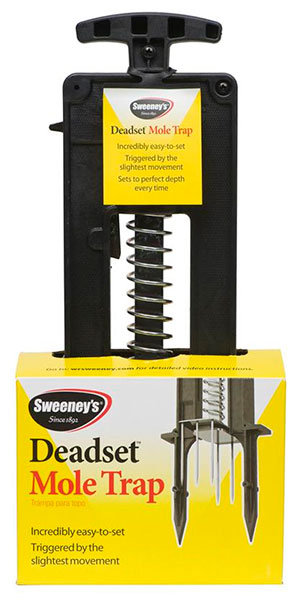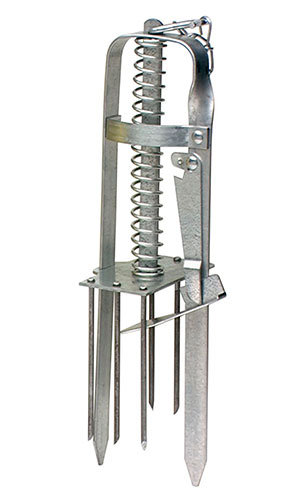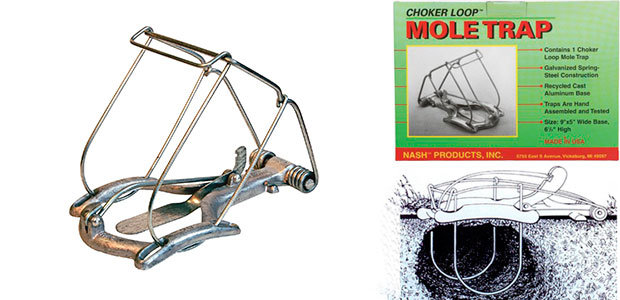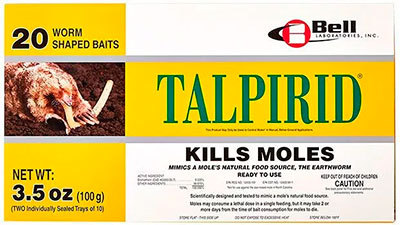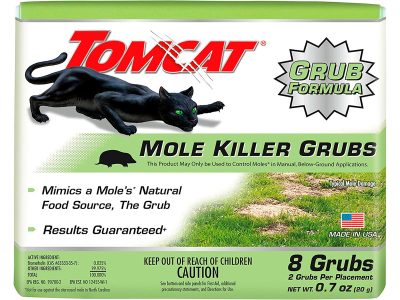Maintaining a beautiful lawn or garden requires effort and dedication, but all that work can be quickly undermined by moles. These subterranean creatures create unsightly mounds and tunnels that damage grass roots and ruin landscapes. Fortunately, there are effective solutions available. This comprehensive guide will help you select the best mole trap for your situation and provide expert advice on successful mole control.
Quick Picks: Best Mole Traps
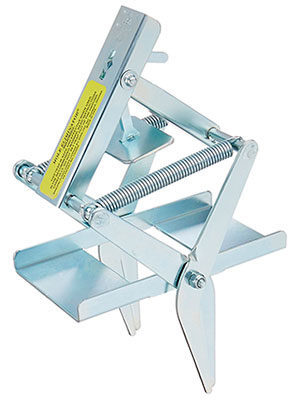
Editor’s Choice

People’s Choice

Most Durable
- Understanding the Mole Problem
- Why Trapping Is the Most Effective Solution
- How to Find Active Mole Tunnels
- Types of Mole Traps
- Best Mole Traps Reviewed
- Humane Options: Live Catch Mole Traps
- Enhancing Trap Effectiveness with Baits
- Expert Tips for Successful Mole Trapping
- Preventing Future Mole Problems
- Frequently Asked Questions
- Conclusion
Understanding the Mole Problem
Moles are insectivores that spend most of their lives underground, creating extensive tunnel systems in search of food. These tunnels can damage plant roots and create unsightly mounds that ruin the appearance of lawns and gardens.
Why Moles Dig
Moles primarily dig to hunt for earthworms, grubs, and other soil invertebrates. A single mole can excavate up to 150 feet of new tunnels daily.
Signs of Infestation
Raised ridges across your lawn, cone-shaped mounds of fresh soil, and damaged plant roots are common indicators of mole activity.
When They’re Active
Moles are active year-round but tend to dig deeper during winter months. They’re most active during spring and fall when soil conditions are ideal.

Fresh mole hill with excavated soil
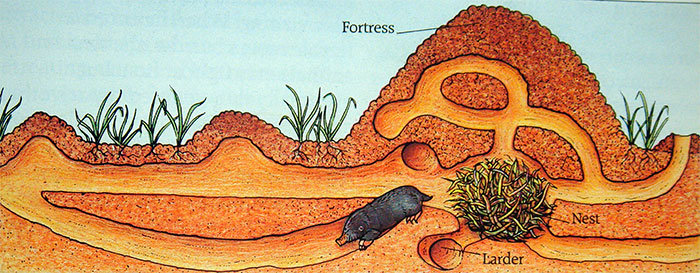
Surface tunnel ridge in lawn
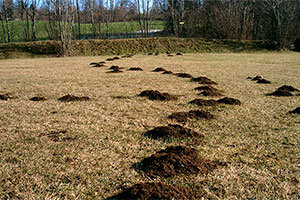
Extensive lawn damage from mole activity
Why Trapping Is the Most Effective Solution
While there are many traditional methods of mole control—from mothballs to smoke bombs—most prove ineffective due to moles’ extensive tunnel systems and their ability to quickly seal off sections when they detect threats.
Unlike chemical options that may harm the environment or pose risks to pets and children, quality mechanical traps provide targeted and humane control. When properly placed in active tunnels, they offer the highest success rate for eliminating mole problems.
Moles are highly sensitive creatures that can detect human scent and ground vibrations. They spend up to 99% of their lives underground, making them difficult to catch without strategic placement of traps in their active tunnels. Understanding mole behavior is key to successful trapping.
How to Find Active Mole Tunnels
Proper trap placement is crucial for success. Here’s how to identify active tunnels where moles are regularly traveling:
Types of Mole Traps
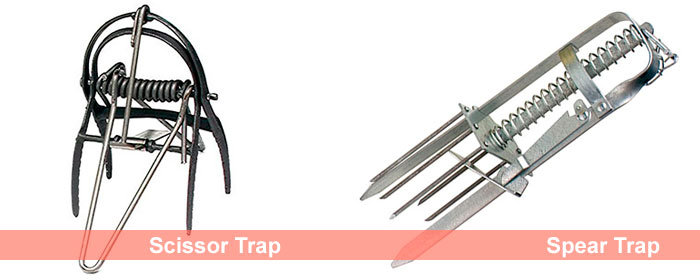
There are several types of mole traps available, each with its own advantages. The most common types include:
| Trap Type | How It Works | Best For |
|---|---|---|
| Scissor/Pincer Traps | Jaws close around the mole when triggered by tunnel disturbance | Deep tunnels, all soil types |
| Harpoon/Spear Traps | Spikes drive downward when the mole pushes up the trigger pan | Shallow tunnels, softer soils |
| Choker Loop Traps | Wire loops tighten around the mole when triggered | Medium-depth tunnels, safety around pets/children |
| Live Catch Traps | Capture moles without killing for relocation | Those preferring humane removal methods |
Best Mole Traps Reviewed
EasySet Mole Eliminator Trap by Wire Tek
Editor's ChoiceHow Does It Work
How to Use
- Locate an active mole tunnel using the stomp test or probe method.
- Clear a small section of the tunnel roof to expose the runway.
- Position the trap over the cleared section with the trigger plate in contact with the runway.
- Press down with your foot to set the trap until it locks in place.
- Check the trap daily and reset as needed.
- No chemicals or poisons required
- Easy to set with foot-pressing mechanism
- Made in USA with durable materials
- Highly effective trigger system
- Can be reused for multiple seasons
- More expensive than some other options
- Requires proper placement for effectiveness
- Spring mechanism can be powerful (use caution)
Tomcat Mole Trap
People's ChoiceHow Does It Work
How to Use
- Find an active mole tunnel and make a 1-inch deep indentation using your heel.
- Use the trap's built-in depth gauge to verify correct depth.
- Mark each side of the indentation using the trap jaws.
- Cut 5-inch slots across the tunnel using a square spade or lawn edger.
- Insert the trap jaws into the slots and press down on the yellow pedal until the trap latches.
- Press the trigger post flush with the top of the foot pedal to complete setup.
- Hands-free setting for safety
- Clear visual indicator when trap is triggered
- No direct contact with captured moles
- Works in various soil types
- Durable construction for multiple uses
- Requires more setup steps than some models
- Slots need to be precisely cut for proper function
- Might be more visible in landscaped areas
Victor Out O'Sight Mole Trap
Most DurableHow Does It Work
How to Use
- Locate an active tunnel and dig out a section approximately the size of the trap.
- Create a channel inside the dirt hole using the trap jaws to ensure they can close properly.
- Use the provided tongs to open the trap and set the safety hook.
- Set the trigger latch on the trigger pan.
- Scoop out most of the dirt from the tunnel, leaving a small mound at the center for the trigger pan.
- Place the trap in the tunnel with its jaws in the middle of the passageway.
- Backfill with loose soil, leaving part of the trap exposed for easy removal.
- Remove the safety hook once everything is in place.
- Extremely durable iron construction
- Weather-resistant for year-round use
- Works in all soil types
- Powerful spring mechanism for reliable triggering
- Includes safety features for handling
- Requires more effort to set than some newer models
- Setup process is more complex
- Strong spring requires careful handling
Sweeney's Deadset Precision Mole Trap
Most Sensitive TriggerHow Does It Work
How to Use
- Find an active surface runway where moles are traveling.
- Clear away a small section of the tunnel roof.
- Position the trap directly over the runway with legs straddling the tunnel.
- Press down firmly to embed the legs into the soil for stability.
- Set the trigger mechanism according to the included instructions.
- Check the trap daily for activity.
- Highly sensitive trigger system
- Can be set with hand or foot pressure
- Clear visual indicator when triggered
- Works well in shallow tunnels
- Easy to reset for multiple uses
- Best suited for surface runways, not deep tunnels
- More visible in the landscape than some models
- May require repositioning if not triggered within a few days
Victor Plunger Style Mole Trap
Best for All Soil TypesHow Does It Work
How to Use
- Locate an active mole runway near the surface.
- Press down on the runway slightly to create a small depression.
- Position the trap over this depression with the spears aligned with the tunnel.
- Push the legs firmly into the ground for stability.
- Set the trigger mechanism according to the included instructions.
- Use the safety clip during setup, and remove it once the trap is properly positioned.
- Works effectively in all soil types
- Weather-resistant construction
- Includes safety features
- Visible indicator when triggered
- Reusable for multiple seasons
- More visible in landscapes than subsurface models
- Requires careful alignment with tunnels
- May need to be moved if not triggered within 2-3 days
Nash Choker Loop Mole Trap
Safest Around PetsHow Does It Work
How to Use
- Locate an active mole tunnel of medium depth.
- Dig a small hole to expose the tunnel system.
- Position the trap so the loops align with the tunnel pathway.
- Set the trigger mechanism according to the instructions.
- Cover the setup with soil or a bucket to block light.
- Check the trap daily for activity.
- Safer design around pets and children
- Below-ground operation for less landscape disruption
- Works well in medium-depth tunnels
- Durable construction for multiple uses
- No sharp exposed parts when set
- Requires more excavation during setup
- Slightly more complex to set than some models
- May be less effective in very shallow tunnels
Humane Options: Live Catch Mole Traps
For those who prefer non-lethal mole control, live catch traps offer an alternative solution. These traps capture moles without harming them, allowing for relocation away from your property.
If you choose to use a live catch trap, research appropriate relocation areas before capturing moles. Suitable locations should be at least 5 miles from your property and provide similar habitat conditions. Always check local regulations regarding wildlife relocation, as some areas have restrictions.
Catch and Release Live Tunnel Trap
Best Humane OptionHow Does It Work
How to Use
- Locate an active mole tunnel using the methods described earlier.
- Carefully dig down to expose the tunnel runway.
- Position the trap so it aligns perfectly with the tunnel direction.
- Cover the trap and surrounding area to block light from entering the tunnel.
- Check the trap regularly throughout the day.
- When a mole is captured, transport the trap to a suitable relocation site at least 5 miles away.
- Split the trap according to the instructions to release the mole without direct handling.
- Completely humane solution
- No chemicals or killing mechanisms
- Easy release mechanism
- Reusable for multiple captures
- Safe for use around children and pets
- Requires more frequent checking than lethal traps
- May be less effective than lethal options
- Necessitates finding appropriate relocation areas
- Moles may return if not relocated far enough away
DIY Live Trap Option
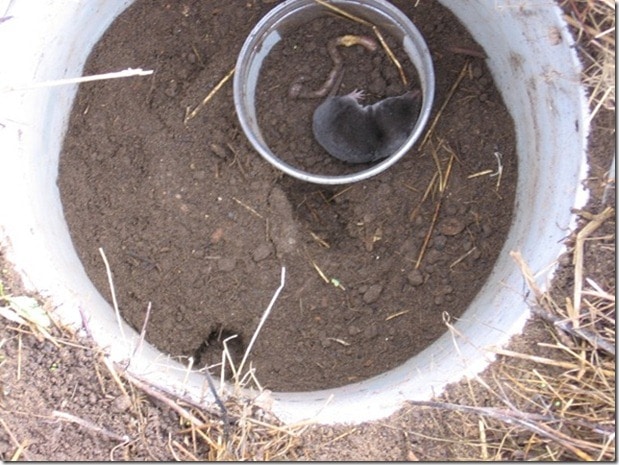
If you prefer a do-it-yourself approach, you can create your own live trap with these common household items:
- A 2-5 gallon bucket
- A shovel
- Protective gloves
- Plywood or sod for covering
DIY Live Trap Instructions:
- Locate an active tunnel and remove a section of the roof.
- Dig a hole beneath the tunnel deep enough to accommodate your bucket.
- Place the bucket in the hole and pack soil around its edge to block the runway.
- Cover the tunnel with sod or plywood to block light while leaving the bucket opening accessible to the mole.
- Check the bucket daily for captured moles.
- Relocate any captured moles at least 5 miles from your property.
This method works because the mole will attempt to clear the blocked tunnel and fall into the bucket, where it remains until you check the trap.
Enhancing Trap Effectiveness with Baits

While high-quality traps can work effectively on their own, using the right bait can increase your success rate, especially in areas with established mole populations.
Talpirid Mole Bait Worms
Most Effective BaitHow Does It Work
How to Use
- Locate active mole tunnels using the probe method.
- Open a small section of the tunnel roof.
- Place one bait worm in the tunnel.
- Cover the opening to prevent light from entering.
- Check tunnels after 24-48 hours to see if the bait has been taken.
- Replace consumed bait as needed.
- Highly effective formula
- Mimics natural mole food
- Works quickly (usually within 24 hours)
- No mechanical parts to set
- Can be used alongside traps for enhanced effectiveness
- Contains poison that requires careful handling
- Should be kept away from children and pets
- May be less effective in areas with abundant natural food
- More expensive than some mechanical options
Tomcat Mole Killer Grubs
Best Grub FormulaHow Does It Work
How to Use
- Wear gloves to avoid transferring human scent to the bait.
- Find active mole tunnels using the probe or stomp test method.
- Open a small section of the tunnel roof.
- Place one grub bait into the tunnel.
- Gently cover the opening to keep light out while maintaining tunnel integrity.
- Check after 1-2 days and replace consumed bait as needed.
- Realistic grub appearance and texture
- Scientifically tested formula
- Pairs well with Tomcat Mole Trap
- Easy to place in tunnels
- Effective against established mole populations
- Contains poison that requires careful handling
- Must be kept away from children and pets
- Works best when natural food sources are scarce
- Requires ongoing monitoring and replacement
Expert Tips for Successful Mole Trapping
Maximize Your Trapping Success
- Time it right: Spring and fall typically see the most mole activity and offer the best trapping opportunities.
- Set multiple traps: Place traps in different active areas to increase your chances of success.
- Be patient: Moles are cautious creatures. Allow 48-72 hours before repositioning unsuccessful traps.
- Check traps daily: Regular monitoring allows you to reset triggered traps or relocate ineffective ones.
- Wear gloves: Always handle traps with gloves rubbed in soil to mask human scent.
- Look for straight runs: Straight tunnel sections are typically travel corridors and make ideal trap locations.
- Maintain tunnel integrity: When placing traps, avoid collapsing the tunnel system which may cause moles to dig new pathways.
- Combine methods: For stubborn infestations, consider using both traps and baits simultaneously.
Preventing Future Mole Problems
Once you’ve successfully eliminated moles from your property, take these preventative measures to reduce the likelihood of future infestations:
Control Grubs
Reduce the mole food supply by treating your lawn for grubs and soil insects with appropriate insecticides or beneficial nematodes.
Plant Natural Repellents
Certain plants like daffodils, marigolds, and alliums contain compounds that moles find unpleasant and may help deter them from your garden.
Adjust Watering
Avoid overwatering your lawn, which brings earthworms closer to the surface and creates ideal conditions for mole tunneling.
Install Barriers
For valuable garden areas, consider installing underground mesh barriers at least 24 inches deep to prevent moles from tunneling into protected zones.
Frequently Asked Questions
How many moles typically live on a residential property?
Most residential properties only have 1-3 moles at any given time. Moles are solitary animals that require large territories (1/4 to 2 acres) for feeding. What often appears to be a large infestation is typically the extensive tunnel system created by just one or two moles.
How quickly do mole traps work?
When properly placed in active tunnels, quality mole traps can work within 24-48 hours. However, success depends on correct placement and the mole’s activity patterns. It’s recommended to leave traps in place for at least 3 days before repositioning them to new locations if no results are seen.
Are mole traps humane?
Many modern mole traps are designed to provide quick, humane elimination. Quality scissor, harpoon, and choker traps typically dispatch moles instantly when properly set. For those concerned about humane treatment, live catch traps offer a non-lethal alternative, though they require more frequent monitoring and appropriate relocation sites.
When is the best time to set mole traps?
Spring (March-May) and fall (September-November) are typically the most effective times for mole trapping, as these seasons see increased mole activity near the surface. Moles are also more active after rainfall when soil is moist and easier to excavate, making these periods ideal for trap placement.
Do ultrasonic repellers work against moles?
Scientific evidence does not support the effectiveness of ultrasonic repellers against moles. While these devices are marketed as humane solutions, studies have shown that moles quickly become accustomed to the vibrations and continue their tunneling activities. Mechanical trapping remains the most reliable control method.
Can I relocate captured moles to a nearby field?
If using live traps, moles should be relocated at least 5 miles away from your property to prevent their return. Choose areas with suitable soil conditions similar to where they were captured. Always check local regulations regarding wildlife relocation, as some areas restrict this practice for certain species.
How can I tell if my trap is placed correctly?
A correctly placed trap should sit firmly in an active tunnel with minimal disturbance to the tunnel structure. For scissor and choker traps, the trigger should be positioned directly in the mole’s path. For harpoon traps, the trigger pan should make light contact with the soil above the tunnel. If a trap hasn’t been triggered after 3 days, it’s likely not in an active tunnel and should be relocated.
Conclusion
Dealing with moles requires patience, proper tools, and an understanding of their behavior. By selecting the right trap for your situation and following best practices for placement and monitoring, you can effectively eliminate these destructive pests from your property.
The most successful mole control strategies combine quality traps placed in active tunnels with preventative measures to make your yard less attractive to future moles. Remember that persistence is key—it may take several attempts and different trap locations before you achieve complete control.
With the information in this guide and the right equipment, you can reclaim your lawn and garden from mole damage and maintain the beautiful outdoor space you’ve worked hard to create.
